2014 Peugeot 3008 Hybrid 4 steering wheel
[x] Cancel search: steering wheelPage 155 of 378
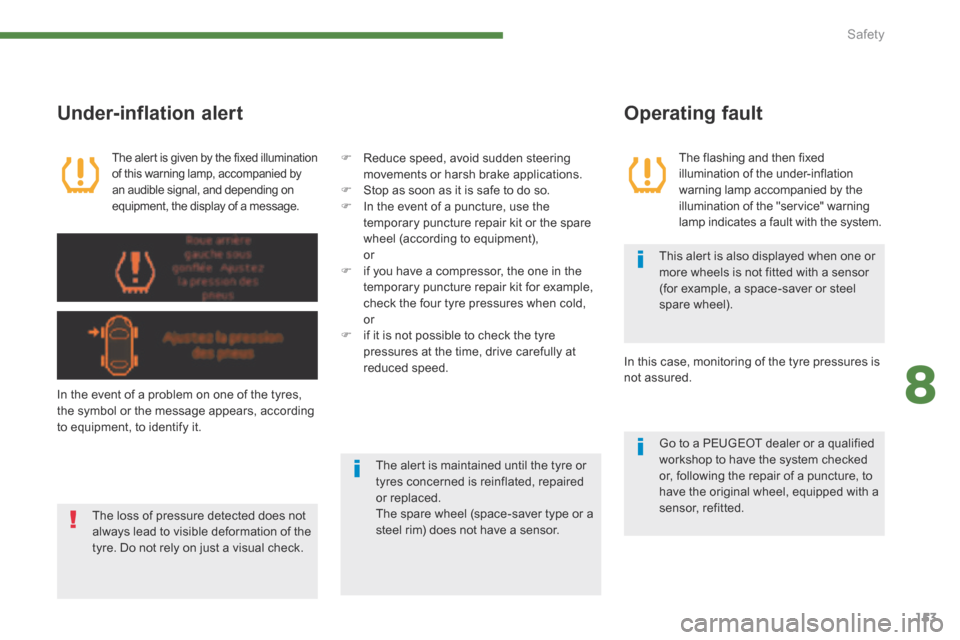
8
Safety153
Under-inflation alert
The alert is given by the fixed illumination of this warning lamp, accompanied by an audible signal, and depending on equipment, the display of a message.
In the event of a problem on one of the tyres, the symbol or the message appears, according to equipment, to identify it.
Reduce speed, avoid sudden steering movements or harsh brake applications. Stop as soon as it is safe to do so. In the event of a puncture, use the temporary puncture repair kit or the spare wheel (according to equipment), or if you have a compressor, the one in the temporary puncture repair kit for example, check the four tyre pressures when cold, or if it is not possible to check the tyre pressures at the time, drive carefully at reduced speed.
The loss of pressure detected does not always lead to visible deformation of the tyre. Do not rely on just a visual check.
The alert is maintained until the tyre or tyres concerned is reinflated, repaired or replaced. The spare wheel (space-saver type or a steel rim) does not have a sensor.
This alert is also displayed when one or more wheels is not fitted with a sensor (for example, a space-saver or steel spare wheel).
Operating fault
The flashing and then fixed illumination of the under-inflation warning lamp accompanied by the illumination of the "service" warning lamp indicates a fault with the system.
Go to a PEUGEOT dealer or a qualified workshop to have the system checked or, following the repair of a puncture, to have the original wheel, equipped with a sensor, refitted.
In this case, monitoring of the tyre pressures is not assured.
Page 162 of 378

Safety
160
Airbags
Front airbags
Deployment
The airbags are deployed, except the passenger's front airbag if it is deactivated, in the event of a serious front impact to all or part of the front impact zone A , in the longitudinal centreline of the vehicle on a horizontal plane and directed from the front to the rear of the vehicle. The front airbag inflates between the thorax and head of the front occupant of the vehicle and the steering wheel, driver's side, and the dashboard, passenger's side to cushion their forward movement.
Impact detection zones
A. Front impact zone. B. Side impact zone.
System designed to maximise the safety of the occupants (with the exception of the rear centre passenger) in the event of violent collisions. The airbags supplement the action of the force-limiting seat belts (with the exception of the centre rear passenger). If a collision occurs, the electronic detectors record and analyse the front and side impacts sustained in the impact detection zones: - in the case of a serious impact, the airbags are deployed instantly and contribute towards better protection of the occupants of the vehicle (with the exception of the rear centre passenger); immediately after the impact, the airbags deflate rapidly so that they do not hinder visibility or the exit of the occupants, - in the case of a minor or rear impact or in certain roll-over conditions, the airbags will not be deployed; the seat belt alone contributes towards ensuring your protection in these situations.
System which protects the driver and front passenger in the event of a serious front impact in order to limit the risk of injury to the head and thorax. The driver's airbag is fitted in the centre of the steering wheel; the front passenger's airbag is
fitted in the dashboard above the glove box.
The airbags do not operate when the ignition is switched off. This equipment will only deploy once. If a second impact occurs (during the same or a subsequent accident), the airbag will not be deployed again.
Deployment of the airbag(s) is
accompanied by a slight emission of smoke and a noise, due to the activation of the pyrotechnic cartridge incorporated in the system. This smoke is not harmful, but sensitive individuals may experience slight irritation. The noise of the detonation may result in a slight loss of hearing for a short time.
Page 165 of 378
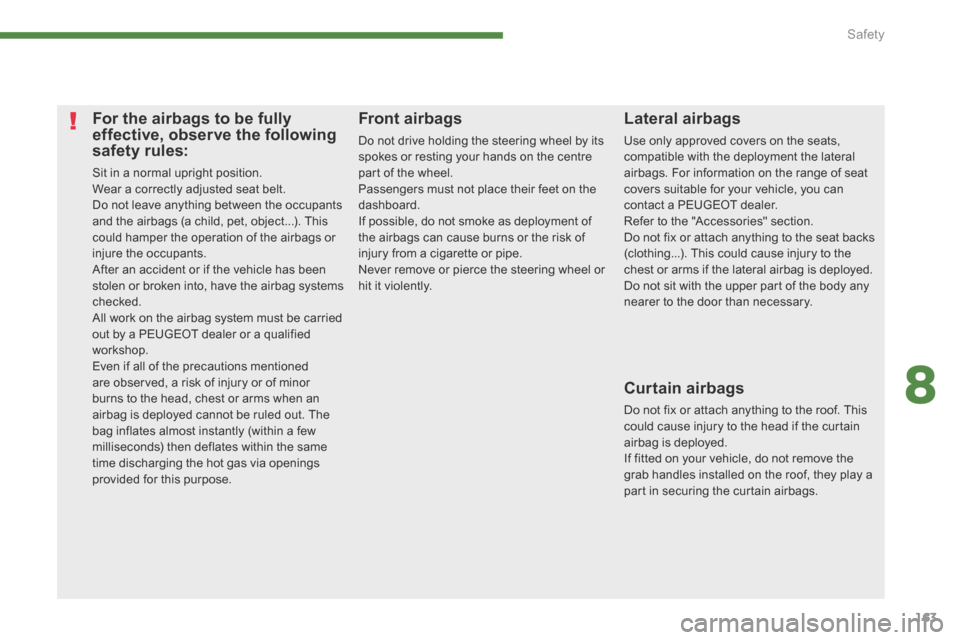
8
Safety163
For the airbags to be fully effective, observe the following safety rules:
Sit in a normal upright position. Wear a correctly adjusted seat belt. Do not leave anything between the occupants and the airbags (a child, pet, object...). This could hamper the operation of the airbags or injure the occupants. After an accident or if the vehicle has been stolen or broken into, have the airbag systems checked. All work on the airbag system must be carried out by a PEUGEOT dealer or a qualified workshop. Even if all of the precautions mentioned are observed, a risk of injury or of minor burns to the head, chest or arms when an airbag is deployed cannot be ruled out. The bag inflates almost instantly (within a few milliseconds) then deflates within the same time discharging the hot gas via openings provided for this purpose.
Lateral airbags
Use only approved covers on the seats, compatible with the deployment the lateral airbags. For information on the range of seat covers suitable for your vehicle, you can contact a PEUGEOT dealer. Refer to the "Accessories" section. Do not fix or attach anything to the seat backs (clothing...). This could cause injury to the chest or arms if the lateral airbag is deployed. Do not sit with the upper part of the body any nearer to the door than necessary.
Front airbags
Do not drive holding the steering wheel by its spokes or resting your hands on the centre part of the wheel. Passengers must not place their feet on the dashboard. If possible, do not smoke as deployment of the airbags can cause burns or the risk of injury from a cigarette or pipe. Never remove or pierce the steering wheel or hit it violently.
Curtain airbags
Do not fix or attach anything to the roof. This could cause injury to the head if the curtain airbag is deployed. If fitted on your vehicle, do not remove the grab handles installed on the roof, they play a part in securing the curtain airbags.
Page 178 of 378
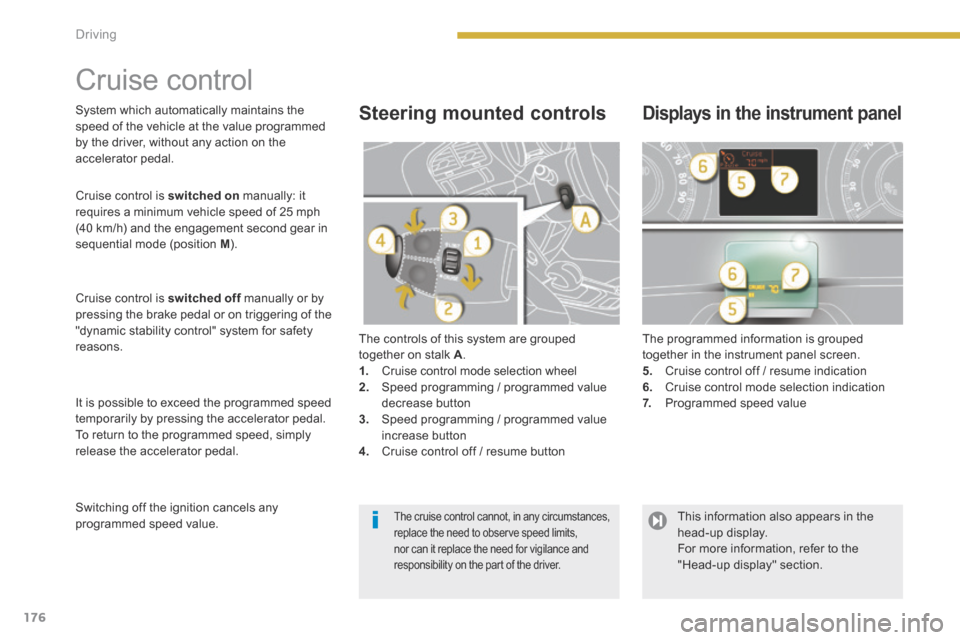
176Driving
Cruise control
The controls of this system are grouped together on stalk A . 1. Cruise control mode selection wheel 2. Speed programming / programmed value decrease button 3. Speed programming / programmed value increase button 4. Cruise control off / resume button
The programmed information is grouped together in the instrument panel screen. 5. Cruise control off / resume indication 6. Cruise control mode selection indication 7. Programmed speed value
Steering mounted controls Displays in the instrument panel
Cruise control is switched on manually: it requires a minimum vehicle speed of 25 mph (40 km/h) and the engagement second gear in sequential mode (position M ).
Cruise control is switched off manually or by switched off manually or by switched offpressing the brake pedal or on triggering of the "dynamic stability control" system for safety reasons.
It is possible to exceed the programmed speed temporarily by pressing the accelerator pedal. To return to the programmed speed, simply release the accelerator pedal.
Switching off the ignition cancels any programmed speed value.
System which automatically maintains the speed of the vehicle at the value programmed by the driver, without any action on the accelerator pedal.
The cruise control cannot, in any circumstances, replace the need to observe speed limits, nor can it replace the need for vigilance and responsibility on the part of the driver.
This information also appears in the head-up display. For more information, refer to the "Head-up display" section.
Page 181 of 378

9
179
Driving
6-speed electronic gearbox
Gear selector
Lift the gear selector to move to position R or R or RM . R. Reverse With your foot on the brake, move the selector for wards to select this position. N. Neutral. With your foot on the brake, select this position to start. A. Automated mode. Move the selector backwards to select this mode. M. Sequential mode with manual changing of the gears at the steering wheel.
Steering mounted controls
"+" Change up paddle to the right of the steering wheel. Press the back of the "+" steering mounted paddle to change up a gear. "-" Change down paddle to the left of the steering wheel. Press the back of the "-" steering mounted paddle to change down a gear.
Six-speed electronic gearbox which offers a choice between the comfort of fully automatic operation or the pleasure of manual gear changing. Three driving modes are offered: - automated mode for automatic control of the gears by the gearbox, - sequential mode for manual changing of the gears by the driver, - auto sequential mode to overtake, for example, remaining in automatic mode while using the functions of the sequential mode.
The steering mounted paddles do not permit the selection of neutral or the engaging or disengaging of reverse g e a r.
Page 200 of 378

Practical information
198
A. "Sealant" or "Air" position selector. B. On "I" / off "O" switch. C. Deflation button. D. Pressure gauge (in bar and p.s.i.). E. Compartment housing: - a cable with adaptor for 12 V socket, - various inflation adaptors for accessories, such as balls, bicycle tyres...
Description of the kit
F. Sealant cartridge. G. White pipe with cap for repair. H. Black pipe for inflation. I. Speed limit sticker.
The speed limit sticker I must be affixed to the vehicle's steering wheel to remind you that a wheel is in temporary use. Do not exceed a speed of 50 mph (80 km/h) when driving with a tyre repaired using this type of kit.
Page 324 of 378
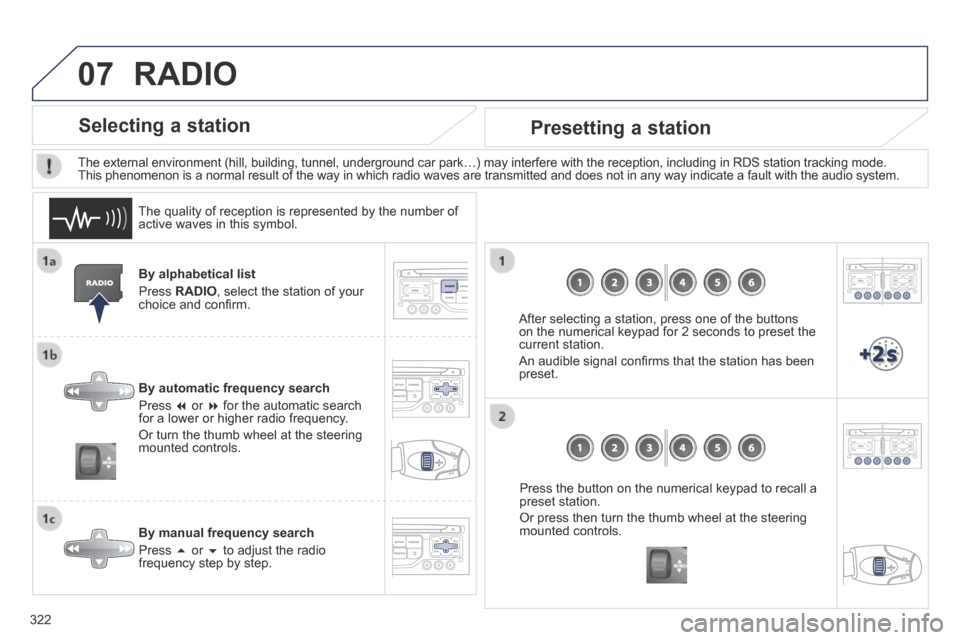
07
322
By alphabetical list
Press RADIO , select the station of your choice and confi rm.
By automatic frequency search
Press or for the automatic search for a lower or higher radio frequency.
Or turn the thumb wheel at the steering mounted controls.
By manual frequency search
Press or to adjust the radio frequency step by step.
Press the button on the numerical keypad to recall a preset station.
Or press then turn the thumb wheel at the steering mounted controls.
Selecting a station
The external environment (hill, building, tunnel, underground car park…\
) may interfere with the reception, including in RDS station tracking mode. This phenomenon is a normal result of the way in which radio waves are t\
ransmitted and does not in any way indicate a fault with the audio system.
Presetting a station
After selecting a station, press one of the buttons on the numerical keypad for 2 seconds to preset the current station.
An audible signal confi rms that the station has been preset.
The quality of reception is represented by the number of active waves in this symbol.
RADIO
Page 365 of 378
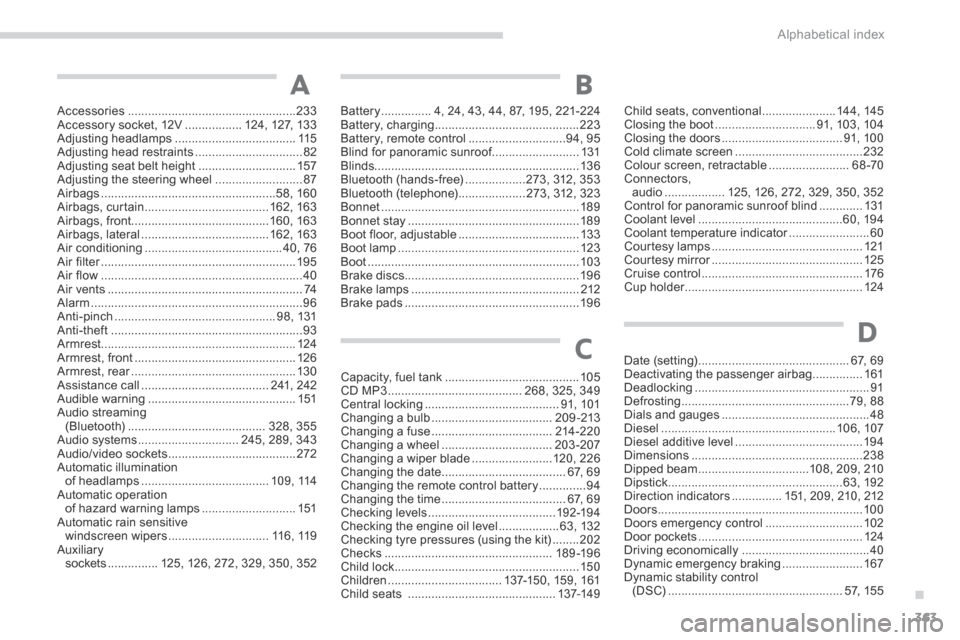
.
Alphabetical index363
Accessories ..................................................233Accessory socket, 12V .................124, 127, 13 3Adjusting headlamps ....................................115Adjusting head restraints ................................82Adjusting seat belt height .............................157Adjusting the steering wheel ..........................87Airbags ....................................................58, 160Airbags, curtain .....................................162, 163Airbags, front.........................................160, 163Airbags, lateral ......................................162, 163Air conditioning .........................................40, 76Air filter ..........................................................Air filter ..........................................................Air filter195Air flow ............................................................40Air vents ..........................................................74Alarm ...............................................................96Anti-pinch ................................................98, 131Anti-theft .........................................................93Armrest ..........................................................124Armrest, front ................................................126Armrest, rear .................................................Armrest, rear .................................................Armrest, rear13 0Assistance call ......................................2 41, 242Audible warning ............................................151Audio streaming (Bluetooth) .........................................328, 355Audio systems ..............................245, 289, 343Audio/video sockets ......................................272Automatic illumination of headlamps ......................................109, 114Automatic operation of hazard warning lamps ............................151Automatic rain sensitive windscreen wipers ..............................11 6, 11 9Auxiliary sockets ...............125, 126, 272, 329, 350, 352
Battery ...............4, 24, 43, 44, 87, 195, 221-224Battery, charging ...........................................223Battery, remote control .............................94, 95Blind for panoramic sunroof ..........................Blind for panoramic sunroof ..........................Blind for panoramic sunroof131Blinds.............................................................13 6Bluetooth (hands-free) ..................273, 312, 353Bluetooth (telephone) ....................273, 312, 323Bonnet ...........................................................189Bonnet stay ...................................................189Boot floor, adjustable ....................................13 3Boot lamp ......................................................123Boot ...............................................................103Brake discs ....................................................19 6Brake lamps ..................................................212Brake pads ....................................................19 6
A
D
Child seats, conventional ......................14 4, 145Closing the boot ..............................91, 103, 104Closing the doors ....................................91, 10 0Cold climate screen ......................................232Colour screen, retractable ........................68-70Connectors, audio ..................125, 126, 272, 329, 350, 352Control for panoramic sunroof blind .............131Coolant level ...........................................60, 19 4Coolant temperature indicator ........................Coolant temperature indicator ........................Coolant temperature indicator60Courtesy lamps .............................................121Courtesy mirror .............................................Courtesy mirror .............................................Courtesy mirror125Cruise control ................................................176Cup holder .....................................................Cup holder .....................................................Cup holder124
Capacity, fuel tank ........................................105CD MP3 ........................................268, 325, 349Central locking ........................................91, 101Changing a bulb ....................................209-213Changing a fuse ....................................214 -2 20Changing a wheel .................................203-207Changing a wiper blade ........................120, 226Changing the date .....................................67, 69Changing the remote control battery ..............94Changing the time .....................................67, 69Checking levels ......................................192-19 4Checking the engine oil level ..................63, 132Checking tyre pressures (using the kit) ........202Checks ..................................................18 9 -19 6Child lock .......................................................150Children ..................................137-150, 159, 161Child seats ............................................137-149
Date (setting) .............................................67, 69Deactivating the passenger airbag ...............161Deadlocking ....................................................91Defrosting ..................................................79, 88Dials and gauges ............................................48Diesel ....................................................10 6, 107Diesel additive level ......................................19 4Dimensions ...................................................238Dipped beam .................................108, 209, 210Dipstick ....................................................63, 192Direction indicators ...............151, 209, 210, 212Doors .............................................................10 0Doors emergency control .............................102Door pockets .................................................124Driving economically ......................................40Dynamic emergency braking ........................167Dynamic stability control (DSC) ....................................................57, 155
C
B